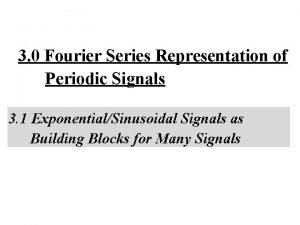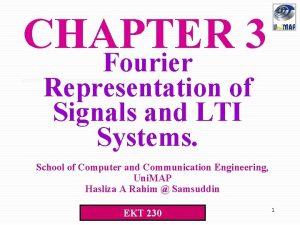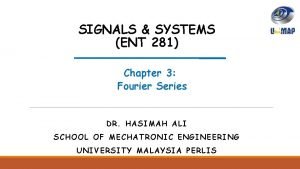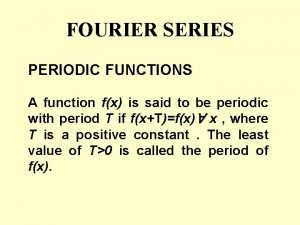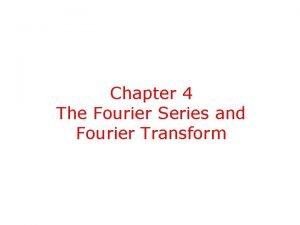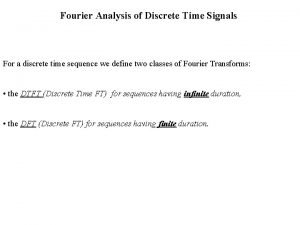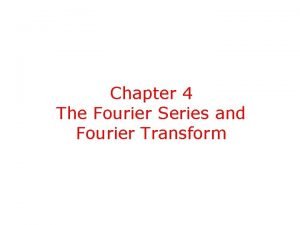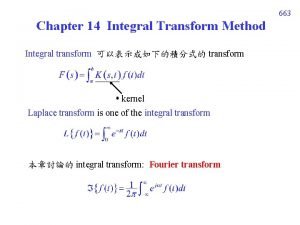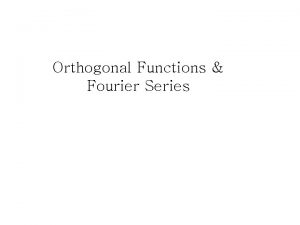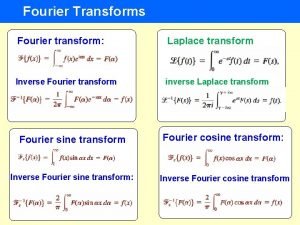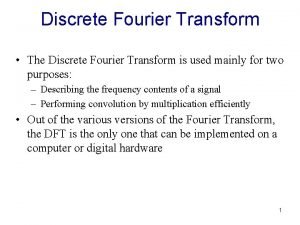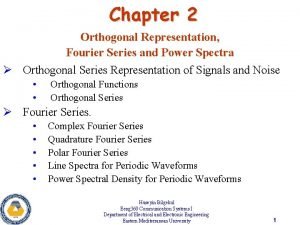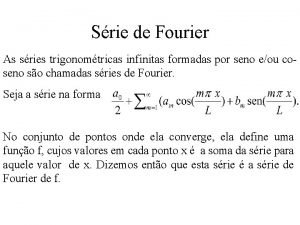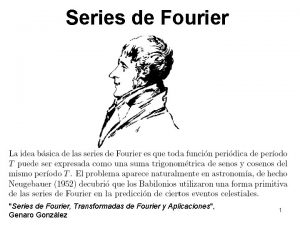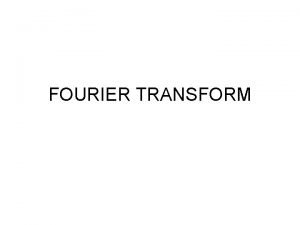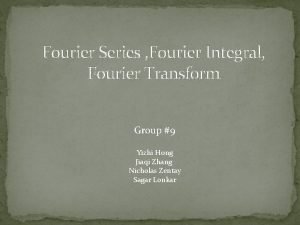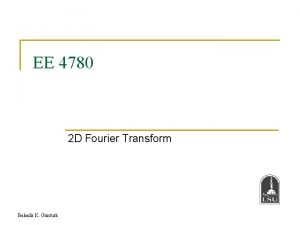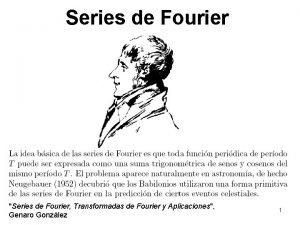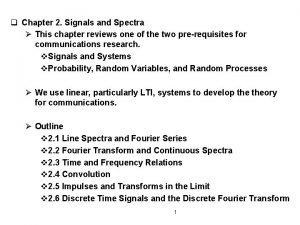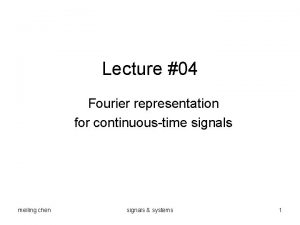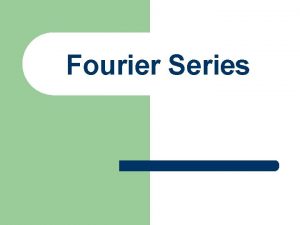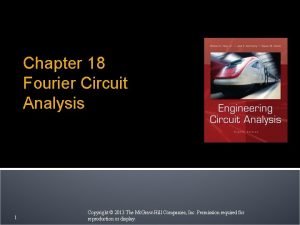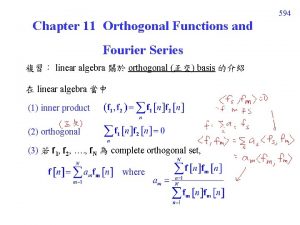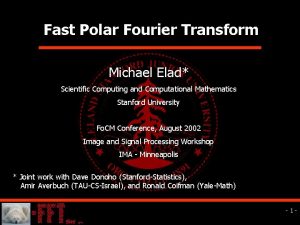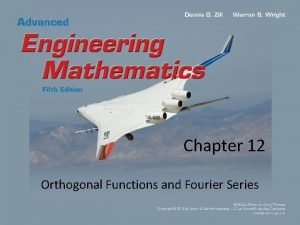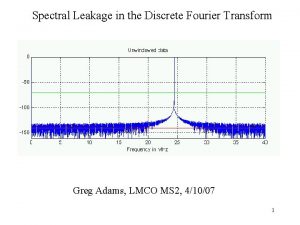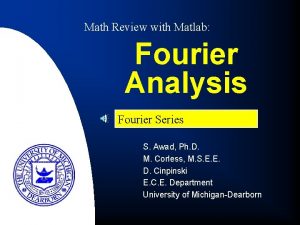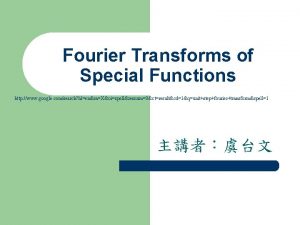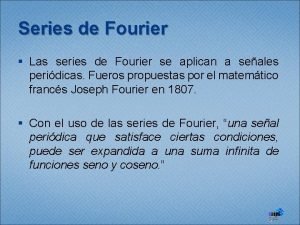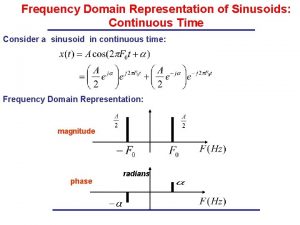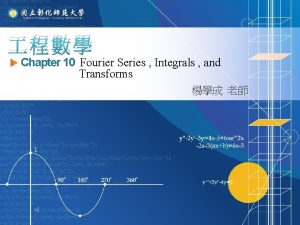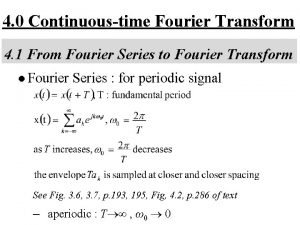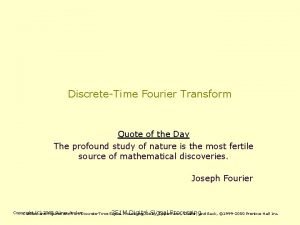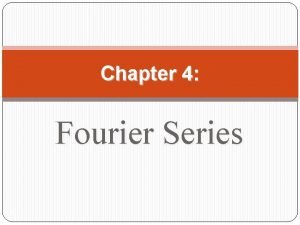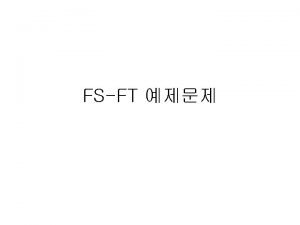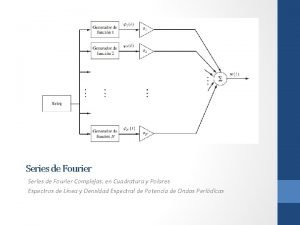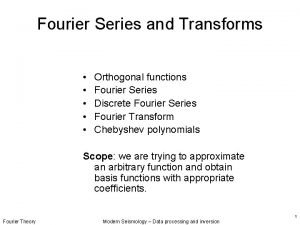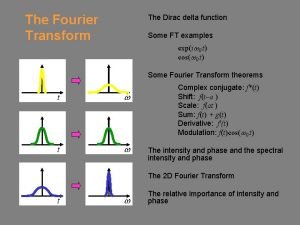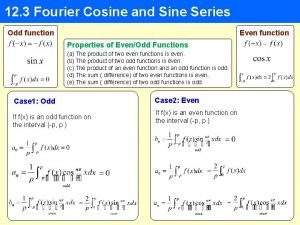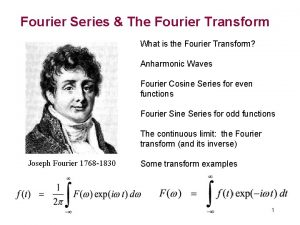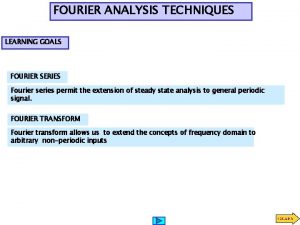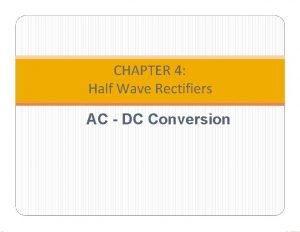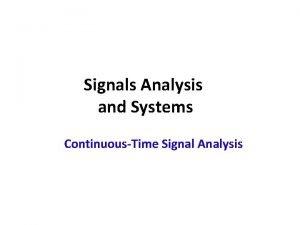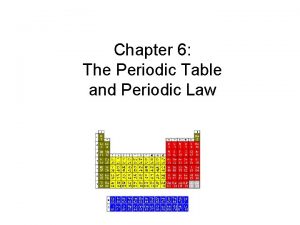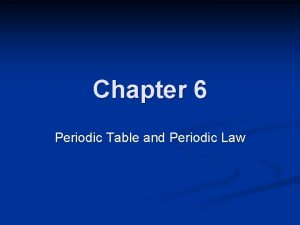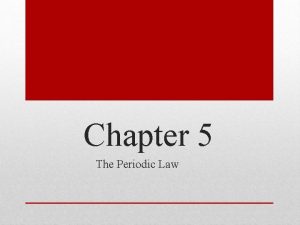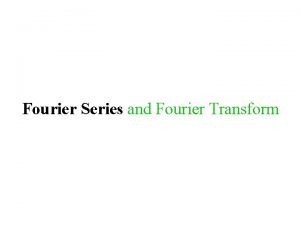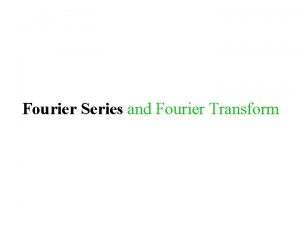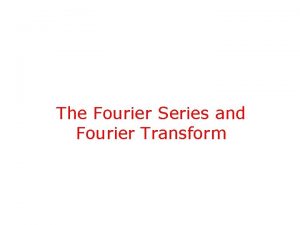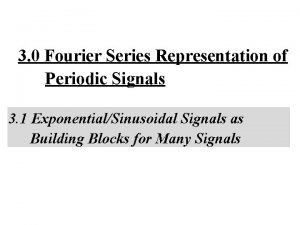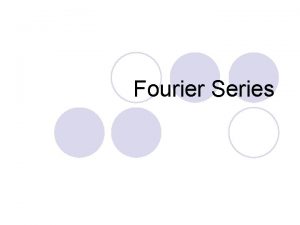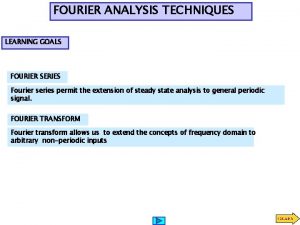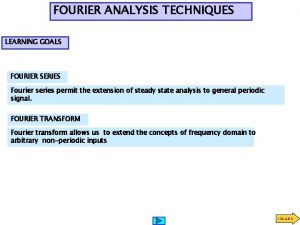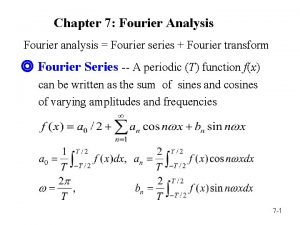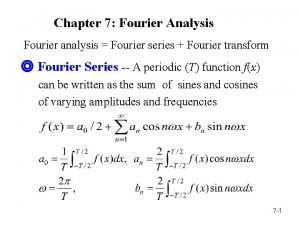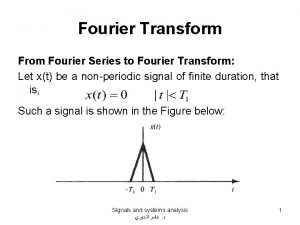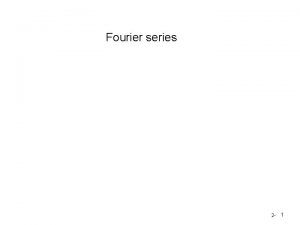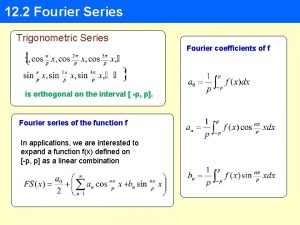3 0 Fourier Series Representation of Periodic Signals








































![Fourier Series Representation Fourier Series l repeat with period N Note: both x[n] and Fourier Series Representation Fourier Series l repeat with period N Note: both x[n] and](https://slidetodoc.com/presentation_image_h/12d6348042d9c9ffdeca19c9ef75556e/image-41.jpg)



![Fourier Series Representation l No Convergence Issue, No Gibbs Phenomenon, No Discontinuity – x[n] Fourier Series Representation l No Convergence Issue, No Gibbs Phenomenon, No Discontinuity – x[n]](https://slidetodoc.com/presentation_image_h/12d6348042d9c9ffdeca19c9ef75556e/image-45.jpg)




![3. 5 Application Example System Characterization y[n], y(t) h[n], h(t) x[n], x(t) δ[n], δ(t) 3. 5 Application Example System Characterization y[n], y(t) h[n], h(t) x[n], x(t) δ[n], δ(t)](https://slidetodoc.com/presentation_image_h/12d6348042d9c9ffdeca19c9ef75556e/image-50.jpg)










![Examples • Example 3. 17, p. 230 of text x[n], x(t) δ[n], δ(t) x[n] Examples • Example 3. 17, p. 230 of text x[n], x(t) δ[n], δ(t) x[n]](https://slidetodoc.com/presentation_image_h/12d6348042d9c9ffdeca19c9ef75556e/image-61.jpg)




- Slides: 65

3. 0 Fourier Series Representation of Periodic Signals 3. 1 Exponential/Sinusoidal Signals as Building Blocks for Many Signals

Time/Frequency Domain Basis Sets l Time Domain l Frequency Domain

Signal Analysis (P. 32 of 1. 0)

Response of A Linear Time-invariant System to An Exponential Signal l Initial Observation time-invariant scaling property 0 t – if the input has a single frequency component, the output will be exactly the same single frequency component, except scaled by a constant

Input/Output Relationship Time Domain l 0 0 Frequency Domain l

Response of A Linear Time-invariant System to An Exponential Signal l More Complete Analysis – continuous-time matrix vectors eigenvalue eigenvector

Response of A Linear Time-invariant System to An Exponential Signal l More Complete Analysis – continuous-time Transfer Function Frequency Response : eigenfunction of any linear time-invariant system : eigenvalue associated with the eigenfunction est

Response of A Linear Time-invariant System to An Exponential Signal l More Complete Analysis – discrete-time Transfer Function Frequency Response eigenfunction, eigenvalue

System Characterization l Superposition Property – continuous-time – discrete-time – each frequency component never split to other frequency components, no convolution involved – desirable to decompose signals in terms of such eigenfunctions

3. 2 Fourier Series Representation of Continuous-time Periodic Signals Fourier Series Representation T: fundamental period l Harmonically related complex exponentials all with period T

Harmonically Related Exponentials for Periodic Signals T • All with period T: integer multiples of ω0 • Discrete in frequency domain

Fourier Series Representation l Fourier Series : j-th harmonic components real

Real Signals For orthogonal basis: (unique representation)

Fourier Series Representation l Determination of ak Fourier series coefficients dc component

Not unit vector orthogonal (分析)

Fourier Series Representation l Vector Space Interpretation – vector space could be a vector space some special signals (not concerned here) may need to be excluded

Fourier Series Representation l Vector Space Interpretation – orthonormal basis is a set of orthonormal basis expanding a vector space of periodic signals with period T

Fourier Series Representation l Vector Space Interpretation – Fourier Series

Fourier Series Representation l Completeness Issue – Question: Can all signals with period T be represented this way? Almost all signals concerned here can, with exceptions very often not important

Fourier Series Representation l Convergence Issue – consider a finite series It can be shown ak obtained above is exactly the value needed even for a finite series

Truncated Dimensions • All truncated dimensions are orthogonal to the subspace of dimensions kept.

Fourier Series Representation l Convergence Issue – It can be shown

Fourier Series Representation l Gibbs Phenomenon – the partial sum in the vicinity of the discontinuity exhibit ripples whose amplitude does not seem to decrease with increasing N See Fig. 3. 9, p. 201 of text


Fourier Series Representation l Convergence Issue – x(t) has no discontinuities Fourier series converges to x(t) at every t x(t) has finite number of discontinuities in each period Fourier series converges to x(t) at every t except at the discontinuity points, at which the series converges to the average value for both sides All basis signals are continuous, so converge to average values

Fourier Series Representation l Convergence Issue – Dirichlet’s condition for Fourier series expansion (1) absolutely integrable, � (2) finite number of maxima & minima in a period (3) finite number of discontinuities in a period

3. 3 Properties of Fourier Series l Linearity

l Time Shift phase shift linear in frequency with amplitude unchanged

l Time Reversal the effect of sign change for x(t) and ak are identical unique representation for orthogonal basis

l Time Scaling positive real number periodic with period T/α and fundamental frequency αω0 ak unchanged, but x(αt) and each harmonic component are different

l Multiplication

l Conjugation unique representation

l Differentiation

l Parseval’s Relation total average power in a period T average power in the k-th harmonic component in a period T

3. 4 Fourier Series Representation of Discrete-time Periodic Signals Fourier Series Representation , periodic with fundamental period N l Harmonically related signal sets all with period only N distinct signals in the set

Harmonically Related Exponentials for Periodic Signals (P. 11 of 3. 0) T • All with period T: integer multiples of ω0 • Discrete in frequency domain

Continuous/Discrete Sinusoidals (P. 36 of 1. 0) 0 1 2 4 3 5

Exponential/Sinusoidal Signals (P. 42 of 1. 0) l Harmonically related discrete-time signal sets all with common period N This is different from continuous case. Only N distinct signals in this set.

Fourier Series Representation (P. 14 of 3. 0) l Determination of ak Fourier series coefficients dc component

(P. 15 of 3. 0) Not unit vector orthogonal (分析)
![Fourier Series Representation Fourier Series l repeat with period N Note both xn and Fourier Series Representation Fourier Series l repeat with period N Note: both x[n] and](https://slidetodoc.com/presentation_image_h/12d6348042d9c9ffdeca19c9ef75556e/image-41.jpg)
Fourier Series Representation Fourier Series l repeat with period N Note: both x[n] and ak are discrete, and periodic with period N, therefore summed over a period of N ‒ (合成) (分析)

Orthogonal Basis

Fourier Series Representation l Vector Space Interpretation is a vector space

Fourier Series Representation l Vector Space Interpretation a set of orthonormal bases
![Fourier Series Representation l No Convergence Issue No Gibbs Phenomenon No Discontinuity xn Fourier Series Representation l No Convergence Issue, No Gibbs Phenomenon, No Discontinuity – x[n]](https://slidetodoc.com/presentation_image_h/12d6348042d9c9ffdeca19c9ef75556e/image-45.jpg)
Fourier Series Representation l No Convergence Issue, No Gibbs Phenomenon, No Discontinuity – x[n] has only N parameters, represented by N coefficients sum of N terms gives the exact value – N odd – N even See Fig. 3. 18, P. 220 of text


Properties l Primarily Parallel with those for continuous-time Multiplication l periodic convolution

Time Shift First Difference

Properties l Parseval’s Relation average power in a period for each harmonic component
![3 5 Application Example System Characterization yn yt hn ht xn xt δn δt 3. 5 Application Example System Characterization y[n], y(t) h[n], h(t) x[n], x(t) δ[n], δ(t)](https://slidetodoc.com/presentation_image_h/12d6348042d9c9ffdeca19c9ef75556e/image-50.jpg)
3. 5 Application Example System Characterization y[n], y(t) h[n], h(t) x[n], x(t) δ[n], δ(t) H(z)zn, H(s)est, z=e jω, s=j H(e jω)e jωn, H(j )e jωt zn , e st e jωn , e jωt n n

Superposition Property – Continuous-time – Discrete-time – H(j ), H(ejω) frequency response, or transfer function

Filtering modifying the amplitude/ phase of the different frequency components in a signal, including eliminating some frequency components entirely – frequency shaping, frequency selective l Example 1 See Fig. 3. 34, P. 246 of text


Filtering l Example 2 See Fig. 3. 36, P. 248 of text


Examples • Example 3. 5, p. 193 of text

Examples • Example 3. 5, p. 193 of text

Examples • Example 3. 5, p. 193 of text (a) (b) (c)

Examples • Example 3. 8, p. 208 of text (a) (b) (c)

Examples • Example 3. 8, p. 208 of text
![Examples Example 3 17 p 230 of text xn xt δn δt xn Examples • Example 3. 17, p. 230 of text x[n], x(t) δ[n], δ(t) x[n]](https://slidetodoc.com/presentation_image_h/12d6348042d9c9ffdeca19c9ef75556e/image-61.jpg)
Examples • Example 3. 17, p. 230 of text x[n], x(t) δ[n], δ(t) x[n] h[n] y[n], y(t) h[n], h(t)

Problem 3. 66, p. 275 of text • .

Problem 3. 70, p. 281 of text • 2 -dimensional signals

Problem 3. 70, p. 281 of text • 2 -dimensional signals different

Problem 3. 70, p. 281 of text • 2 -dimensional signals
 Fourier series
Fourier series Dtft representation of
Dtft representation of Series de fourier
Series de fourier Fourier series half range
Fourier series half range Fourier series
Fourier series Fourier series of periodic function
Fourier series of periodic function Animals and human language chapter 2
Animals and human language chapter 2 What was the first human language
What was the first human language Communicative signals and informative signals
Communicative signals and informative signals Parseval's equation
Parseval's equation Fourier analysis of discrete time signals
Fourier analysis of discrete time signals Fourier series multiplication property
Fourier series multiplication property Geometric representation of signals
Geometric representation of signals Fourier transform pair
Fourier transform pair Periodic analog signals
Periodic analog signals Fourier sine series
Fourier sine series Fourier series
Fourier series Discrete time fourier series
Discrete time fourier series Polar fourier series
Polar fourier series What is time domain and frequency domain
What is time domain and frequency domain Transformata fourier
Transformata fourier Series de fourier
Series de fourier Series complejas de fourier
Series complejas de fourier Sin(2pift)
Sin(2pift) Fourier series of cos x from- pi to pi
Fourier series of cos x from- pi to pi Impulse train fourier transform
Impulse train fourier transform Fourier
Fourier Line spectrum in signals and systems
Line spectrum in signals and systems Series de fourier
Series de fourier Series de fourier
Series de fourier Fourier series circuit analysis
Fourier series circuit analysis Orthogonality of trigonometric functions
Orthogonality of trigonometric functions Fourier transform equation
Fourier transform equation Polar fft
Polar fft Fourier series and orthogonal functions
Fourier series and orthogonal functions Fourier series
Fourier series Matlab fourier series coefficients
Matlab fourier series coefficients Half range fourier series formula
Half range fourier series formula Full wave rectified sine wave fourier series
Full wave rectified sine wave fourier series Unit impluse
Unit impluse Series de fourier
Series de fourier Dirichlet conditions
Dirichlet conditions Parseval's theorem in signals and systems
Parseval's theorem in signals and systems Fourier series of even and odd functions
Fourier series of even and odd functions Fourier series multiplication property
Fourier series multiplication property Fourier transform
Fourier transform Define half range series
Define half range series Fourier series
Fourier series Wolfram fourier series
Wolfram fourier series Series fourier
Series fourier Discrete time fourier series
Discrete time fourier series Quarter wave symmetry fourier series
Quarter wave symmetry fourier series Fourier series formula
Fourier series formula Serie compleja de fourier
Serie compleja de fourier Orthogonal functions in fourier series
Orthogonal functions in fourier series Inverse fourier transform of delta function
Inverse fourier transform of delta function Series de fourier
Series de fourier Fourier serires
Fourier serires Use of fourier series
Use of fourier series Formula of vrms in half wave rectifier
Formula of vrms in half wave rectifier Define fourier series of a function
Define fourier series of a function How to find out group and period of an element
How to find out group and period of an element Chapter 6 periodic table
Chapter 6 periodic table The periodic table and periodic law chapter 6
The periodic table and periodic law chapter 6 Chapter 5 periodic law
Chapter 5 periodic law Radius trend periodic table
Radius trend periodic table
